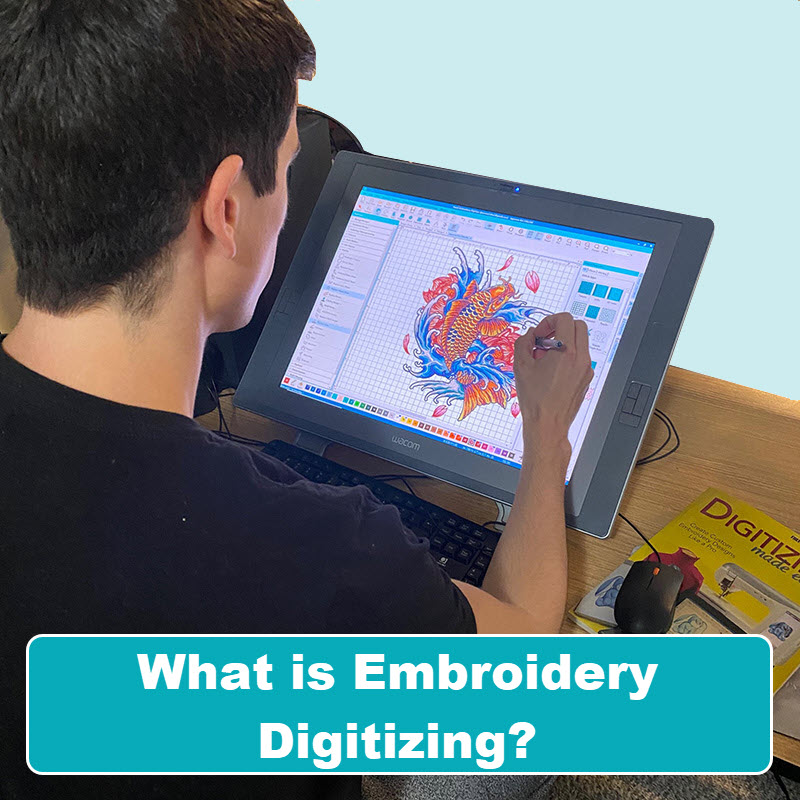Streamlining the Art of Needlework Digitizing: Step-by-Step Guide
Embroidery digitizing is a precise craft that requires precision and creativity. As technology proceeds to advancement, the digitization procedure has ended up being extra accessible, permitting fanatics to bring their detailed styles to life with ease. In this overview, we will certainly decipher the complexities of needlework digitizing, breaking down each action systematically to improve the process and encourage both novices and experienced embroiderers alike. Stay tuned to uncover exactly how you can streamline this complex art form and transform your innovative visions into magnificently embroidered masterpieces.
Recognizing Needlework Digitizing Software
Embroidery digitizing software application acts as an important device for transforming intricate layouts right into digital formats suitable with embroidery equipments, facilitating accurate stitching and modification. This customized software program permits users to import various picture documents formats, such as JPG or PNG, and convert them right into embroidery machine-readable styles like DST, EXP, or PES - Digitizing for Embroidery. By using attributes like stitch editing, rug choices, and thread shade selection, digitizing software application enables users to regulate every aspect of the design procedure
In addition, progressed embroidery digitizing software provides tools for developing intricate layouts, adjusting stitch thickness, and incorporating elaborate information. Individuals can also sneak peek the layout prior to stitching it out, ensuring precision and minimizing errors. Additionally, numerous software application provide automated functions that help enhance the digitizing process, saving time and initiative.
Comprehending the capabilities of embroidery digitizing software application is necessary for achieving top notch cause needlework tasks. By understanding this tool, needlework enthusiasts and experts can release their creativity and bring intricate designs to life with accuracy and efficiency.

Picking the Right Design Documents
After acquainting yourself with the abilities of needlework digitizing software, the next critical action in the procedure is selecting the right style apply for your project. Digitizing for Embroidery. When selecting a style declare needlework digitizing, it's essential to take into consideration the complexity of the style, the dimension of the final item, and the kind of textile you will be collaborating with
For elaborate styles with fine details, a high-resolution picture or vector data is recommended to make sure that the embroidery maker can precisely replicate the design. In addition, the size of the last product plays a considerable duty in selecting the ideal style data. Larger styles might require higher resolution data to preserve quality and sharpness.
Furthermore, the type of fabric you will certainly be embroidering on influences the option of layout data. Various materials may require adjustments in the style data to make sure that the stitches are properly aligned and the style looks like meant. By Extra resources very carefully choosing the right right here design data based upon these variables, you can establish yourself up for a successful needlework digitizing process.
Digitizing Tools and Techniques
Making use of specialized software program and accuracy methods, digitizing devices are essential in transforming detailed layouts into embroidery-ready files. Embroidery digitizing software, such as Wilcom, Hatch, or Embrilliance, offers the essential platform to transform art work into stitch data. These programs use attributes like stitch editing, padding alternatives, and text tools to make certain the design translates effortlessly onto textile.
One of the crucial methods in digitizing is developing a clear course for the needlework equipment to comply with. This entails digitizing each aspect of the layout with precision, determining stitch kinds, thickness, and directions. By using devices like digitizing tablet computers or software-specific plugins, embroiderers can accomplish a high level of accuracy in their digitized layouts.
In addition, mastering the art of padding sewing is critical for generating high quality embroidery. Underlay stitching stabilizes the fabric and develops a structure for the style, making sure that the final product is both visually enticing and long-lasting. By recognizing these digitizing devices and strategies, embroiderers can raise their craft and bring complex styles to life with precision and efficiency.
Tailoring Stitch Kinds and Instructions
The option of stitch kinds can substantially affect the general appearance and appearance of the stitched style. By strategically incorporating these stitch types, embroiderers can achieve depth and measurement in their styles.
Moreover, the instructions of stitches plays a critical role in boosting the visual charm of the last needlework. Varying stitch directions can include appearance, highlight particular aspects, and develop visual rate of interest. For example, changing the angle of stitches can mimic motion or all-natural patterns like hair or feathers. By trying out with different stitch angles and patterns, embroiderers can bring their designs to life with exceptional information and complexity. Grasping the art of tailoring stitch kinds and directions empowers embroiderers to unleash their imagination and raise the top quality of their job.
Screening and Refining Your Digitized Design
To guarantee the precision and high quality of your digitized layout, extensive testing and refinement are important action in the embroidery digitizing procedure. As soon as you have actually completed the digitization of the original source your design, it is essential to evaluate it before waging the real needlework. Examining permits you to determine any type of prospective problems such as thread breaks, stitch density problems, or design distortions that may influence the outcome.

After testing, it is essential to fine-tune your digitized style based upon the responses from the examination sew-out. This might entail tweaking sew settings, readjusting thickness, or making changes to the overall style to attain the preferred end result. By iterating via screening and refinement, you can fine-tune your digitized style to perfection prior to moving on with the real embroidery procedure.
Final Thought
Finally, understanding the art of embroidery digitizing calls for a thorough understanding of the software application, picking the ideal layout documents, using digitizing tools and methods, customizing stitch kinds and directions, and screening and fine-tuning the digitized layout. By complying with these actions, embroiderers can simplify the digitizing procedure and create high-quality stitched layouts with precision and performance.
Comments on “Ideal Digitizing for Embroidery: Boost Your Tasks”